Abstract
OBJECTIVES: Past research on low birthweight has focused on individual-level risk factors. We sought to assess the contribution of macrolevel social factors by using census tract-level data on social stratification, community empowerment, and environmental stressors. METHODS: Census tract-level information on social risk was linked to birth certificate records from Baltimore, Md, for the period 1985 through 1989. Individual level factors included maternal education, maternal age, medical assistance health insurance (Medicaid), and trimester of prenatal care initiation. Methods of multilevel modeling using two-stage regression analyses were employed. RESULTS: Macrolevel factors had both direct associations and interactions with low birthweight. All individual risk factors showed interaction with macrolevel variables; that is, individual-level risk factors for low birthweight behaved differently depending upon the characteristics of the neighborhood of residence. For example, women living in high-risk neighborhoods benefited less from prenatal care than did women living in lower-risk neighborhoods. CONCLUSIONS: Multilevel modeling is an important tool that allows simultaneous study of macro- and individual-level risk factors. Multilevel analyses should play a larger role in the formulation of public health policies.
Full text
PDF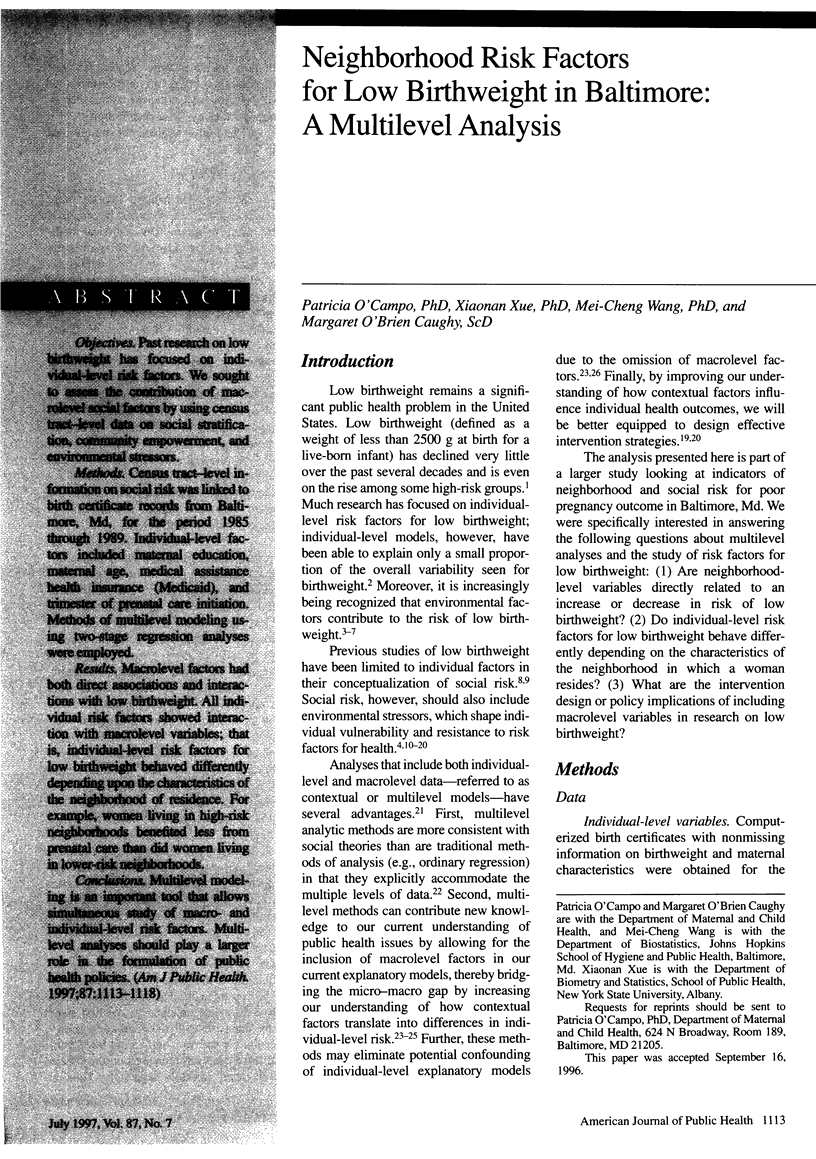
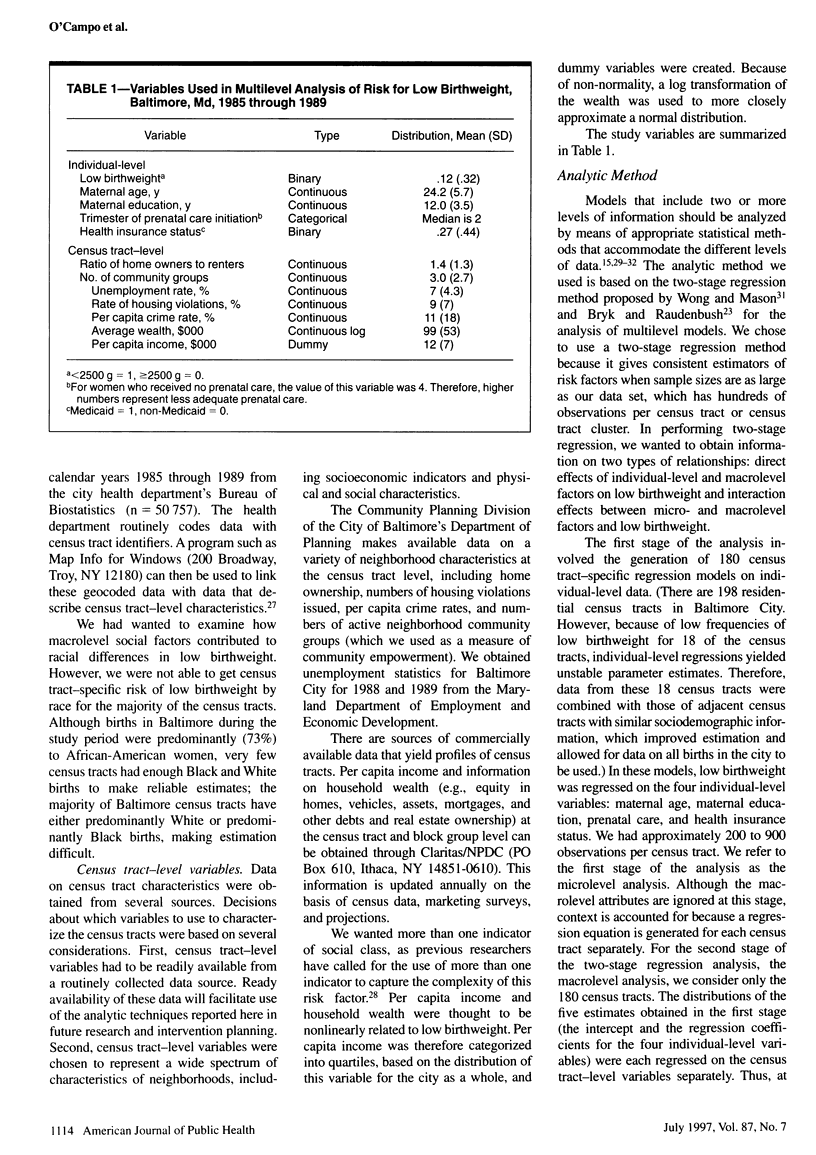
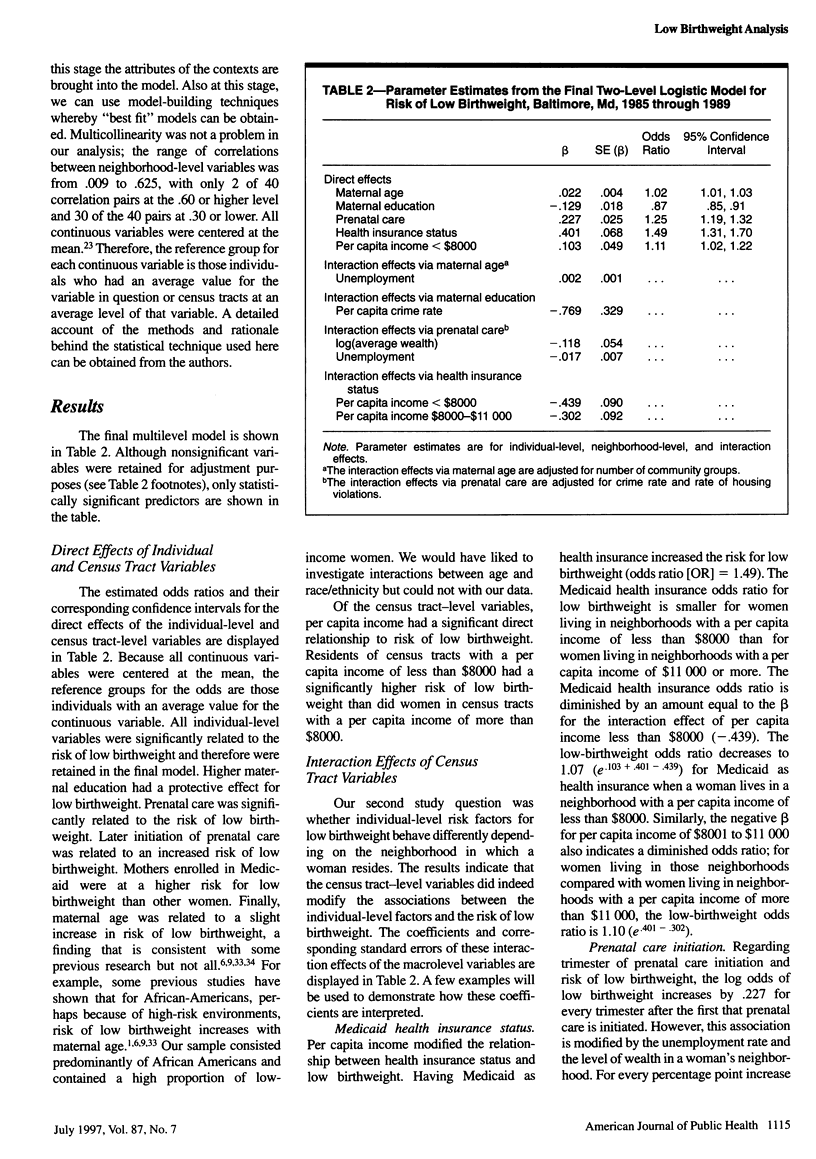
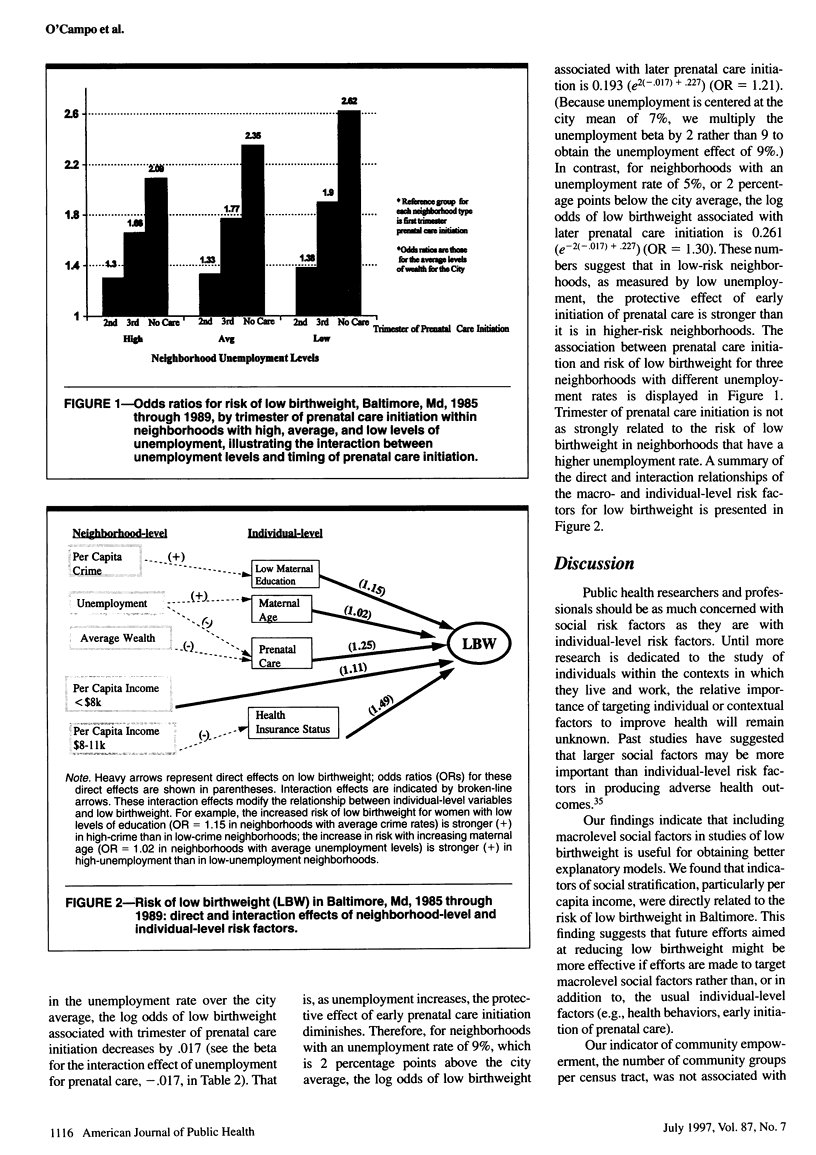
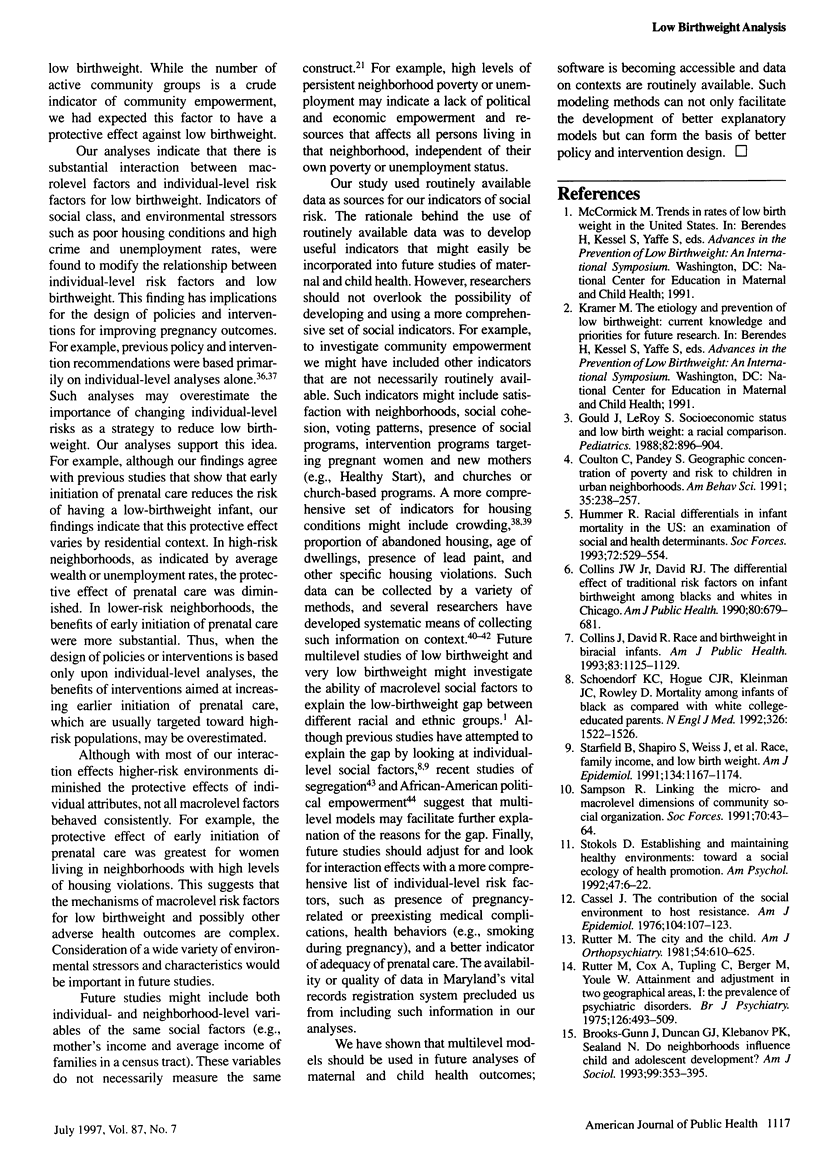

Selected References
These references are in PubMed. This may not be the complete list of references from this article.
- Cassel J. The contribution of the social environment to host resistance: the Fourth Wade Hampton Frost Lecture. Am J Epidemiol. 1976 Aug;104(2):107–123. doi: 10.1093/oxfordjournals.aje.a112281. [DOI] [PubMed] [Google Scholar]
- Collins J. W., Jr, David R. J. Race and birthweight in biracial infants. Am J Public Health. 1993 Aug;83(8):1125–1129. doi: 10.2105/ajph.83.8.1125. [DOI] [PMC free article] [PubMed] [Google Scholar]
- Collins J. W., Jr, David R. J. The differential effect of traditional risk factors on infant birthweight among blacks and whites in Chicago. Am J Public Health. 1990 Jun;80(6):679–681. doi: 10.2105/ajph.80.6.679. [DOI] [PMC free article] [PubMed] [Google Scholar]
- Geronimus A. T. Black/white differences in the relationship of maternal age to birthweight: a population-based test of the weathering hypothesis. Soc Sci Med. 1996 Feb;42(4):589–597. doi: 10.1016/0277-9536(95)00159-x. [DOI] [PubMed] [Google Scholar]
- Goeppinger J., Baglioni A. J., Jr Community competence: a positive approach to needs assessment. Am J Community Psychol. 1985 Oct;13(5):507–523. doi: 10.1007/BF00923264. [DOI] [PubMed] [Google Scholar]
- Gould J. B., LeRoy S. Socioeconomic status and low birth weight: a racial comparison. Pediatrics. 1988 Dec;82(6):896–904. [PubMed] [Google Scholar]
- Haan M., Kaplan G. A., Camacho T. Poverty and health. Prospective evidence from the Alameda County Study. Am J Epidemiol. 1987 Jun;125(6):989–998. doi: 10.1093/oxfordjournals.aje.a114637. [DOI] [PubMed] [Google Scholar]
- Krieger N. Overcoming the absence of socioeconomic data in medical records: validation and application of a census-based methodology. Am J Public Health. 1992 May;82(5):703–710. doi: 10.2105/ajph.82.5.703. [DOI] [PMC free article] [PubMed] [Google Scholar]
- Lepore S. J., Evans G. W., Palsane M. N. Social hassles and psychological health in the context of chronic crowding. J Health Soc Behav. 1991 Dec;32(4):357–367. [PubMed] [Google Scholar]
- Liberatos P., Link B. G., Kelsey J. L. The measurement of social class in epidemiology. Epidemiol Rev. 1988;10:87–121. doi: 10.1093/oxfordjournals.epirev.a036030. [DOI] [PubMed] [Google Scholar]
- Muntaner C., O'Campo P. J. A critical appraisal of the demand/control model of the psychosocial work environment: epistemological, social, behavioral and class considerations. Soc Sci Med. 1993 Jun;36(11):1509–1517. doi: 10.1016/0277-9536(93)90393-i. [DOI] [PubMed] [Google Scholar]
- O'Campo P., Gielen A. C., Faden R. R., Xue X., Kass N., Wang M. C. Violence by male partners against women during the childbearing year: a contextual analysis. Am J Public Health. 1995 Aug;85(8 Pt 1):1092–1097. doi: 10.2105/ajph.85.8_pt_1.1092. [DOI] [PMC free article] [PubMed] [Google Scholar]
- Pittman J., Andrews H., Struening E. The use of zip coded population data in social area studies of service utilization. Eval Program Plann. 1986;9(4):309–317. doi: 10.1016/0149-7189(86)90045-5. [DOI] [PubMed] [Google Scholar]
- Rutter M., Cox A., Tupling C., Berger M., Yule W. Attainment and adjustment in two geographical areas. I--The prevalence of psychiatric disorder. Br J Psychiatry. 1975 Jun;126:493–509. doi: 10.1192/bjp.126.6.493. [DOI] [PubMed] [Google Scholar]
- Rutter M. The city and the child. Am J Orthopsychiatry. 1981 Oct;51(4):610–625. doi: 10.1111/j.1939-0025.1981.tb01407.x. [DOI] [PubMed] [Google Scholar]
- Schoendorf K. C., Hogue C. J., Kleinman J. C., Rowley D. Mortality among infants of black as compared with white college-educated parents. N Engl J Med. 1992 Jun 4;326(23):1522–1526. doi: 10.1056/NEJM199206043262303. [DOI] [PubMed] [Google Scholar]
- Schwartz S. The fallacy of the ecological fallacy: the potential misuse of a concept and the consequences. Am J Public Health. 1994 May;84(5):819–824. doi: 10.2105/ajph.84.5.819. [DOI] [PMC free article] [PubMed] [Google Scholar]
- Smith S. J. Health status and the housing system. Soc Sci Med. 1990;31(7):753–762. doi: 10.1016/0277-9536(90)90170-w. [DOI] [PubMed] [Google Scholar]
- Stokols D. Establishing and maintaining healthy environments. Toward a social ecology of health promotion. Am Psychol. 1992 Jan;47(1):6–22. doi: 10.1037//0003-066x.47.1.6. [DOI] [PubMed] [Google Scholar]
- Strobino D., O'Campo P., Schoendorf K. C. A strategic framework for infant mortality reduction: implications for "Healthy Start". Milbank Q. 1995;73(4):507–533. [PubMed] [Google Scholar]
- Zeger S. L., Liang K. Y., Albert P. S. Models for longitudinal data: a generalized estimating equation approach. Biometrics. 1988 Dec;44(4):1049–1060. [PubMed] [Google Scholar]


